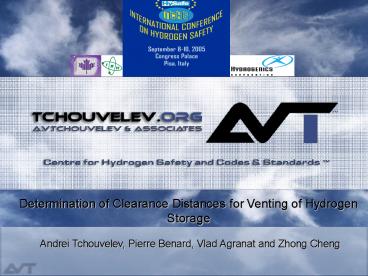NFPA World Safety presentation - PowerPoint PPT Presentation
1 / 14
Title:
NFPA World Safety presentation
Description:
Andrei Tchouvelev, Pierre Benard, Vlad Agranat and Zhong Cheng. Acknowledgements ... practical application: contribute to development of model codes and engineering ... – PowerPoint PPT presentation
Number of Views:155
Avg rating:3.0/5.0
Title: NFPA World Safety presentation
1
Determination of Clearance Distances for Venting
of Hydrogen Storage Andrei Tchouvelev, Pierre
Benard, Vlad Agranat and Zhong Cheng
2
Acknowledgements
- Work partially supported by
- Natural Resources Canada (NRCan) CTFCA Clearance
Distance Project - Natural Sciences and Engineering Research Council
of Canada (NSERC) Industrial Research Fellowship
3
Introduction
- Part of Hydrogen Clearance Distances Project
under Canadian Transportation Fuel Cell Alliance
(CTFCA) - RD study with practical application contribute
to development of model codes and engineering
guidelines for design of vent stacks for hydrogen
venting under conditions of a hydrogen energy
station - Innovative approach
- Clearance distances related to venting of
hydrogen storage were differentiated between
distances to people and equipment (at 1.8 m above
ground) and distances to air intakes and ignition
sources (located above the top of a vent stack) - Recommended clearance distances are based on
extents of 100 LFL hydrogen concentration
envelopes plus 25 safety factor - Obtained tables and graphs were based on CFD
modeling of hydrogen releases and dispersion,
implemented through the PHOENICS software package
and on thermal effects analysis using TNO Yellow
Book recommendations
4
International Fire Code, Section 2209
5
Thermal Level Standards for Hazard Assessment
6
API Recommended Practice 521
- Flame length varies with emission velocity and
heat release. Information on the subject is
limited and is usually based on VISUAL
observations in connection with emergency
discharges from flares. Figures 8 and 9 were
developed from some PLANT-SCALE experimental work
on flame lengths covering relatively high release
rates of various mixtures of hydrogen and
hydrocarbons.
7
API Recommended Practice 521
8
Hydrogen Release from Vent Stack2000 CFM, 30
ft/s (9.14 m/s) wind
9
Hydrogen Release from Vent Stack2000 CFM, 30
ft/s (9.14 m/s) wind
10
Clearance Distances Based on Concentration
Envelopes
11
Recommended Clearance Distances For Ignition
Sources Above Vent Stack Top
12
Clearance Distances Based on Thermal Effects
Sonic flows correspond to lowest stack diameter
in each flow rate range. It is interesting that
the best sonic (coloured green) and subsonic
(coloured yellow) results in terms of distances
to 1,500 BTU/ft2 for each flow rate range are
quite close to each other. This indicates that if
an appropriate height of the vent stack is
selected, the stack orifice will not materially
affect the clearance distance.
13
Recommended Clearance Distances Based on Thermal
Effects
14
Summary
- Clearance distances related to venting of
hydrogen storage were derived using both thermal
effects and concentration envelope approaches - Obtained tables and graphs were based on thermal
effects analysis using TNO Yellow Book
recommendations and CFD modeling of hydrogen
releases and dispersion, implemented through the
PHOENICS software package - Obtained results provide comprehensive guidance
to both design engineers and regulatory
authorities to design and provide regulatory
approvals for placement of hydrogen storage
systems vent stacks































